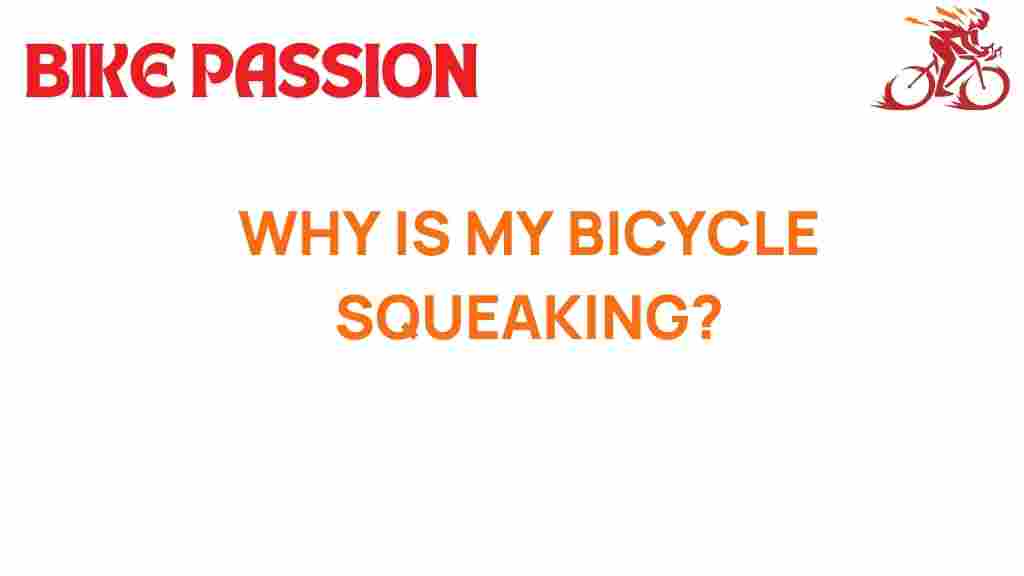Unraveling the Mystery: Why Is My Bicycle Squeaking?
If you’re an avid cyclist, you might have encountered that pesky squeaking noise coming from your bike at some point. Not only can it be annoying, but it can also indicate underlying issues that need to be addressed. Understanding why your bicycle is squeaking is essential for effective bicycle maintenance. In this comprehensive guide, we will delve into the common causes of squeaks, how to troubleshoot them, and provide valuable cycling tips to keep your bike in optimal condition.
Understanding the Causes of a Squeaking Bicycle
A bicycle can produce a variety of noises, and a squeak can often be attributed to several common issues. Here’s a breakdown of the most frequent culprits:
- Chain Issues: A dry or rusty chain can create a squeaking sound when pedaled.
- Brake Components: Worn brake pads or improperly aligned brakes can cause squeaking.
- Loose Parts: Any loose bolts on the frame or components can lead to unwanted noises.
- Wheel Bearings: If the wheel bearings are dry or damaged, you may hear a squeaking noise while riding.
- Seat and Handlebars: If the seat or handlebars are not tightened correctly, they can squeak when weight is applied.
Step-by-Step Troubleshooting Guide
Now that we have identified some of the common issues causing a squeaking noise, let’s explore a step-by-step troubleshooting process to help you identify and fix these problems.
Step 1: Inspect Your Chain
Start by checking your bicycle chain. A dry or rusty chain is one of the most common causes of squeaking. Follow these steps:
- Clean the chain with a suitable degreaser.
- Inspect for rust or wear; replace if necessary.
- Lubricate the chain with high-quality bike chain lubricant.
Step 2: Check the Brakes
Your brakes are another potential source of noise. Here’s how to check them:
- Examine the brake pads for wear; replace if they are worn down.
- Ensure the brake calipers are aligned properly.
- Check for debris between the brake pads and rim.
Step 3: Tighten Loose Parts
Loose components can create annoying sounds. Perform the following checks:
- Inspect all bolts on the frame and components.
- Use a torque wrench to tighten any loose bolts to the manufacturer’s specifications.
- Pay special attention to the seat and handlebar clamps.
Step 4: Examine Wheel Bearings
If the noise persists, inspect your wheel bearings:
- Lift the bike and spin the wheels.
- Listen for unusual noises or roughness while spinning.
- If you suspect issues, consult a professional bike mechanic for further assistance.
Additional Cycling Tips for Bicycle Maintenance
Regular bicycle maintenance can prevent many of the issues that lead to squeaking. Here are some essential cycling tips for keeping your bike in top shape:
- Regular Cleaning: Wash your bike regularly to remove dirt and debris that can cause wear on components.
- Lubrication: Keep your chain and moving parts well-lubricated to ensure smooth operation.
- Tire Care: Check tire pressure regularly and inspect for wear or damage.
- Brake Checks: Regularly inspect and adjust your brakes for optimal performance.
- Seasonal Maintenance: Consider a professional tune-up at the beginning of each cycling season.
Common Issues and How to Address Them
Here are some other common issues that can lead to annoying bicycle noises and how to troubleshoot them:
1. Creaking Bottom Bracket
A creaking noise when pedaling can often be attributed to the bottom bracket. To troubleshoot:
- Check the tightness of the crank arms.
- Inspect the bottom bracket for wear or damage.
- Consider re-greasing or replacing the bottom bracket if needed.
2. Squeaky Pedals
If your pedals are squeaking, here’s what to do:
- Check the pedal bearings; clean and lubricate if necessary.
- Ensure the pedals are securely attached to the crank arms.
- If squeaking persists, consider replacing the pedals.
3. Noise from the Derailleur
A noisy derailleur can affect shifting performance. Follow these steps:
- Check for proper alignment of the derailleur.
- Ensure the derailleur hanger is straight.
- Lubricate the pivot points of the derailleur.
When to Consult a Bike Mechanic
While many issues can be solved with basic troubleshooting and maintenance, there are times when you should consult a professional bike mechanic. Here are a few scenarios:
- If you notice persistent noises after performing maintenance.
- When you are unsure about the condition of critical components like the bottom bracket or wheel bearings.
- If you lack the tools or experience to perform specific repairs.
For professional help, consider visiting your local bike shop or finding a reputable mechanic online. You can also refer to resources like Bike Mechanic for additional guidance.
Conclusion
A squeaking bicycle can be both a nuisance and a sign of underlying issues that require attention. By understanding the common causes of squeaking noises and following our comprehensive troubleshooting guide, you can effectively maintain your bike and enhance your riding experience. Remember, regular bicycle maintenance is key to avoiding these common issues, ensuring that your bike rides smoothly and quietly. With the right care and attention, you can enjoy many more miles of peaceful cycling.
For more tips on bike care and rider advice, feel free to explore our other articles or visit our resources for more insights!
This article is in the category Maintenance and created by BikePassion Team
